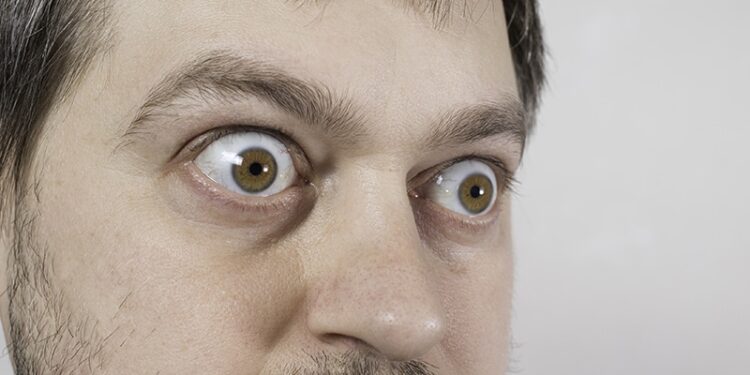In the busy pipeline of potential treatments for thyroid eye disease (TED), the novel agent Veligrotug showed safety and efficacy in both moderate-to-severe active and chronic TED in the phase 3 THRIVE and THRIVE-2 trials.
These results, presented at ENDO 2025: The Endocrine Society Annual Meeting, resulted in the granting of a Breakthrough Therapy designation from the FDA, allowing for an accelerated review as a potential alternative to the only approved treatment, teprotumumab.
TED can significantly affect quality of life. In addition to causing potentially debilitating visual dysfunction and cosmetic disfigurement, it can exact a heavy psychosocial burden. “The addition of treatment options like veligrotug, pending regulatory approval, would provide patients and their doctors with more flexibility to address the common problems that afflict patients with thyroid eye disease, such as proptosis, inflammation, and diplopia,” senior author Raghu Mudumbai, MD, of the Department of Ophthalmology, University of Washington Medical Center, in Seattle, told Medscape Medical News.
Teprotumumab, a fully human immunoglobulin G1 monoclonal antibody that inhibits the insulin-like growth factor-1 receptor (IGF-1R), received FDA approval based on the evidence of its efficacy in the treatment of TED, however, veligrotug and several others stand to fulfill the important need for other options, explained Amy Patel Jain, MD, first author of THRIVE-2, in presenting the findings.
“The space is becoming more crowded in the sense of treatment options, [because] more options are certainly needed to provide improved convenience, efficacy, and safety,” said Jain, of Department of Ophthalmology, Cedars Sinai Medical Center, Los Angeles.
Veligrotug, also an anti-IGF-1R antibody, is delivered intravenously, and according to a press statement from the manufacturer, Viridian Therapeutics, it offers a unique approach with “a differentiated dosing regimen that features a shorter infusion time and fewer infusions compared to the currently approved and marketed IGF-1R inhibitor.”
Specifically, while teprotumumab’s regimen involves eight infusions, given 3 weeks apart, with a 60- to 90-minute infusion time, veligrotug involves five infusions given 3 weeks apart, with a 30-minute infusion time, the company reported.
THRIVE Study Shows Improved Proptosis, Diplopia
For the THRIVE trial, researchers enrolled 113 patients in North America, Australia, and Europe, all of whom had moderate-to-severe active TED ≤ 15 months and demonstrated proptosis of ≥ 3 mm.
Patients were randomized to treatment with five IV infusions, 3 weeks apart, either with 10 mg/kg of veligrotug (n = 75) or placebo (n = 38).
Patients had a mean proptosis of 23.2 mm at baseline in each group, their clinical activity score (CAS) was 4.5 with veligrotug and 4.8 with placebo, and diplopia was present in 67% and 68% of patients, respectively.
At 15 weeks, patients treated with veligrotug had a substantially greater improvement in proptosis with 70% of patients achieving a proptosis responder rate (PRR) improvement of at least a 2 mm reduction, assessed by Hertel exophthalmometry vs baseline, than just 5% of those treated with placebo, with a mean reduction of 2.9 mm vs 0.5 mm in the groups, respectively (P < .0001 for both).
Likewise, the achievement of PRR when assessed by MRI/CT was 69% for veligrotug compared with 9% for placebo, with reductions of 2.9 mm vs 0.6 mm, respectively (P < .0001 for both).
The reduction in clinical activity, assessed by CAS, was 3.4 in the veligrotug group vs 1.7 in the placebo group (P < .0001).
Among patients with diplopia, 54% (27 of 50) in the veligrotug group had a complete resolution of symptoms compared with 12% (3 of 26) in the placebo group (P < .0001).
Adverse events (AEs) were mild for most patients and occurred in 88% of those in the veligrotug group vs 63% of those in the placebo group. Four patients on veligrotug had serious AEs, which were all determined to be unrelated to treatment.
As has been reported with teprotumumab, hearing impairment AEs were also reported in 16% of patients receiving veligrotug vs in 11% of those receiving placebo.
In phase 2 and 3 studies of teprotumumab, the rate of hearing impairment was about 10%, however, other studies have suggested potentially higher rates, including one recent real world study of teprotumumab, showing new subjective ontological symptoms in 29% of patients.
The THRIVE trial is continuing to assess outcomes over 52 weeks, and Viridian Therapeutics recently announced in a press statement that 70% of proptosis responders at week 15 continued to maintain their response at week 52.
THRIVE 2: Chronic TED
For the THRIVE-2 trial, 188 patients with moderate-to-severe, chronic phase TED, with proptosis > 2 mm above normal were randomized to veligrotug (n = 125) or placebo (n = 63) infusions, receiving five infusions 3 weeks apart.
In this study, patients treated with veligrotug had a significantly greater improvement in proptosis, with 56% showing a reduction of ≥ 2 mm over baseline, assessed by Hertel exophthalmometry, compared with 8% of those treated with placebo, with a mean reduction of 2.9 mm vs 0.5 mm, respectively (P < .0001 for both).
Based on MRI/CT assessments, the PRRs were 48% vs 3% (P < .0001).
Of those with diplopia at baseline, 56% had significant improvement in the diplopia responder rate vs 25% of those with placebo, with complete resolution of diplopia reported in 32% vs 14% (P = .0152).
In patients with CAS ≥ 3 at baseline, an exploratory endpoint of a score of CAS 0/1 was achieved in 54% vs 24% (P = .0060 for nominal) at 15 weeks.
Of note, improvements in both trials were observed in patients as early as 3 weeks after the first infusion.
AEs in THRIVE-2 were similar to those seen in the THRIVE trial, with the most common treatment-emergent AEs being muscle spasms, (36% with veligrotug vs 6% with placebo) and menstrual disorders (33% vs 10% for menstruating women).
Hearing impairment occurred in 13% of veligrotug patients vs in 3% of placebo patients, with serious AEs occurring in 2% vs 3%, with one related to treatment in each group.
Jain underscored that the THRIVE-2 trial “is the first global randomized controlled trial of IGF-1R inhibition in chronic TED to show significant improvement not only in proptosis but also in subjective diplopia.”
Regarding key concerns of hearing changes that can occur with TED medications, Mudumbai noted that “the mechanisms [of the hearing effects] are not fully understood at this time but may include irritation of the cochlear hair cells of the ear and inflammation.”
Studies have indicated, however, that the adverse hearing effects are often self-limited, with recovery after cessation of treatment.
“Patients with preexisting hearing loss may have a higher severity of hearing loss,” he added. “If permanent, it may require the use of hearing aids.”
Other cautions regarding veligrotug include the need for careful evaluation and potential treatment for hyperglycemia, and caution is recommended in patients with inflammatory bowel disease, Mudumbai noted.
New Options a ‘Good Development’
Commenting on the research, Marco Medici, MD, PhD, of Erasmus Medical Center, in Rotterdam, the Netherlands, who moderated the session, said the potential to have further options in terms of therapies approved for TED should be a welcome advancement for the field.
“After decades of treating TED with aspecific immunosuppressive drugs with multiple side effects, the introduction of the IGF-1-receptor targeted drug teprotumumab was a real milestone within this field,” he told Medscape Medical News.
“However, side effects are important to take into account, with a particular focus on hearing problems.”
“For this reason, it is a good development that other drugs which target the same pathway are being developed, with a potential further optimalization between effectiveness and patient burden, including side effects, mode (IV vs subcutaneous) and frequency of dosing.”
The THRIVE trials were sponsored by Viridian Therapeutics. Medici reported that he and his team participated in a Viridian Therapeutics trial.
Source link : https://www.medscape.com/viewarticle/veligrotug-shows-promise-treating-thyroid-eye-disease-2025a1000juq?src=rss
Author :
Publish date : 2025-07-28 11:19:00
Copyright for syndicated content belongs to the linked Source.











